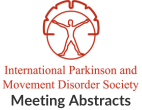Session Information
Date: Monday, October 8, 2018
Session Title: Parkinson's Disease: Non-Motor Symptoms
Session Time: 1:15pm-2:45pm
Location: Hall 3FG
Objective: To classify patients with early Parkinson’s disease based on nonmotor symptoms using a data-driven approach.
Background: Heterogeneity of Parkinson’s disease provides the basis for clinical classification. Proper classification of PD helps with scientific researches and clinical practice. In contrast with the widely accepted motor subtypes (tremor-dominant and PIGD subtypes), no consensus has been reached on how to group PD patients by nonmotor symptoms.
Methods: Data were collected in 342 PD patients (disease duration≤5 years, Hoehn-Yahr stage≤3) from a multicenter clinical trial. The motor section of the Unified Parkinson’s Disease Rating Scale (UPDRS-III) was used to evaluate motor symptoms. A battery of scales and questionnaires was administered to assess nonmotor symptoms, including depression, sleep disorder, apathy, hallucination, constipation and fatigue. A k-means cluster analysis was performed to generate PD subtypes based on nonmotor symptoms.
Results: Three nonmotor subtypes were identified. Subtype 1 was comprised of patients with mild motor and nonmotor symptoms (n=196, 57.3%). Subtype 2 had individuals with prominent apathy and depression (n=124, 36.3%). Subtype 3 was characterized by hallucination (n=22, 6.4%). Patients in three subgroups had similar age, age of onset, and disease duration.
Conclusions: We identified three nonmotor subtypes of Parkinson’s disease using cluster analysis. The preliminary results need to be confirmed by further studies.
To cite this abstract in AMA style:
X. Xu, P. Chan. Clinical subtypes of Parkinson’s disease based on nonmotor symptoms: A cluster analysis [abstract]. Mov Disord. 2018; 33 (suppl 2). https://www.mdsabstracts.org/abstract/clinical-subtypes-of-parkinsons-disease-based-on-nonmotor-symptoms-a-cluster-analysis/. Accessed November 30, 2025.« Back to 2018 International Congress
MDS Abstracts - https://www.mdsabstracts.org/abstract/clinical-subtypes-of-parkinsons-disease-based-on-nonmotor-symptoms-a-cluster-analysis/
